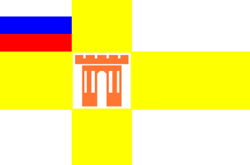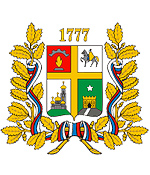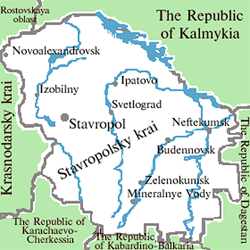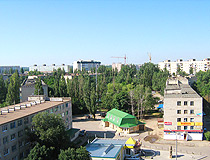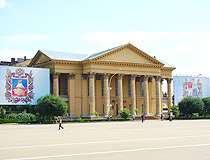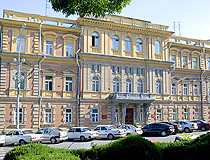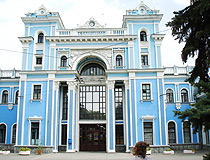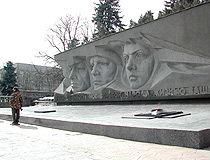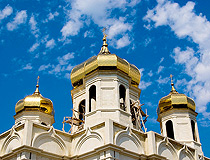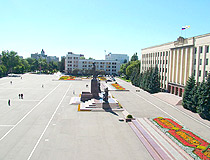History of Stavropol
Foundation of Stavropol
People began to settle in the territory of present-day Stavropol and its environs in ancient times. This is evidenced by more than 20 settlements found by archaeologists here (from the Eneolithic era (4-3 millennium BC) to the Middle Ages).
With the arrival of the Polovtsians (Cumans), a Turkic nomadic people, sedentary life was interrupted. The Nogais and Kalmyks roamed here. In 1556, Astrakhan was taken by Russian troops and the Astrakhan Khanate ceased to exist. This opened the way for Russia to the North Caucasus and the Caspian Sea.
As a result of the Russian-Turkish war of 1768-1774, a new border was established from the mouth of the Terek River to Mozdok and further north-west to the fortress of St. Dmitry (Rostov-on-Don) and Azov. The need arose to protect this region on the southern outskirts of the Russian Empire by building a chain of fortresses.
In 1777, the fortress of Stavropol was founded - one of ten fortresses in the Azov-Mozdok defensive line. For the construction of fortresses and service in the garrisons, the Volga and Don Cossacks were relocated to the Caucasus.
The main work on the construction of the fortress was completed in 1778. It was a pentagon surrounded by earthen ramparts and ditches with a total length of 1,698 meters and an area of 10 hectares. In 1779, the fortress was attacked by a 1,500-strong detachment of Caucasian highlanders. The assault was repulsed and the fortress was not damaged. Retired soldiers began to settle near the fortress. They were supplied with weapons, oxen and horses. In 1782, 494 retired soldiers already lived there.
More Historical Facts…
Stavropol in the 19th century
In 1809-1811, the earthen structures were replaced by stone defensive barracks. At the same time, to the east of the fortress, the Stavropol village of the Khopersky Cossack regiment arose, where its headquarters was located. The central part of the village was in the area currently occupied by the municipal market #1 (Nizhny).
Creating the Azov-Mozdok defensive line during the aggravation of the struggle with the Ottoman Empire for the North-Western Caucasus, the Russian government set itself the task of strengthening the borders and maintaining peaceful relations with the Circassians and other mountain peoples. The military administration of the Caucasus sought to establish economic ties with them - to develop the exchange and sale of goods. Stavropol became one of these centers.
Stavropol became a kind of main gateway to the Caucasus. The Great Cherkassky highway passed through the town connecting St. Petersburg and Moscow with the Caucasus. In 1816, the first printing house in the North Caucasus appeared here. In 1847, Caucasian Oblast was transformed into Stavropol Governorate with the center in the town of Stavropol. It began to play an increasingly prominent role in the cultural life of the Caucasus. In 1853, the population of Stavropol was about 17,000 people.
After the uprising of the Decembrists, a lot of its participants were exiled here. In 1837-1841, Stavropol was visited by Mikhail Lermontov, exiled to the Caucasus. Here he met with Dr. N.V. Mayer, who became the prototype for Dr. Werner in Lermontov’s novel “A Hero of Our Time”. In 1845, the first Russian theater in the Caucasus was opened in Stavropol.
With the formation of Kuban and Terek Cossack oblasts and the end of the Caucasian War, the military-political and economic importance of Stavropol dropped sharply. This trend was further aggravated by the construction of the Rostov-Vladikavkaz railway, which opened in 1875. Stavropol found itself far away from the railway. However, it still remained one of the centers of the grain trade. Telegraph communication between Moscow and Tehran, London, Bombay was carried out through Stavropol and Tiflis.
Stavropol in the 20th century and beyond
At the beginning of the 20th century, there were 27 Orthodox parishes in Stavropol, a Catholic church, a synagogue, a Lutheran church, and a mosque. In 1913, the population of Stavropol was about 62,400 people. In the 1920s-1930s, almost all of them were closed. Only the Assumption Church, built in 1849, was not closed and functioned without interruption.
In 1934, Ordzhonikidze Krai with the center in Pyatigorsk was formed from the huge North Caucasian Krai. In 1935, Stavropol was renamed Voroshilovsk (in honor of Kliment Voroshilov, a prominent Soviet military officer and politician). In 1937, the center of the region was transferred from Pyatigorsk to Voroshilovsk.
According to the 1939 census, the city had 85 thousand residents. On August 3, 1942, during the Second World War, it was captured by the Germans. The city was liberated by the Red Army on January 21, 1943.
In 1943, Ordzhonikidze Krai was renamed into Stavropol Krai, the city of Voroshilovsk - into Stavropol. The rationale was as follows: “the difference in the name of the regional center and the region causes difficulties for institutions and citizens”.
In 1946, an industrial natural gas field was discovered near Lake Sengileevskoye. By the mid-1950s, the construction of the city gas pipeline was completed. In 1951, Stavropol was awarded the first place among the cities of Russia for the best landscaping. This success was repeated in 1952 and 1954. In the same years, the Central City Park repeatedly won the title of “The Best Park in Russia”. In 1956, there were 123,000 residents in Stavropol.
The 1960s-1970s saw the peak of industrial construction in Stavropol. During this period, dozens of enterprises of mechanical engineering, light, chemical, construction, food, processing, and other industries were commissioned, reconstructed and updated. In 1989, the population of Stavropol was about 318,000 people.
In 2014 and 2016, Stavropol took first place and was recognized as the most comfortable city in Russia.
Architecture of Stavropol
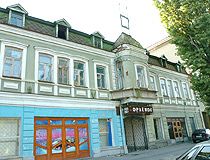
Old building in Stavropol
Author: Yuri Syuganov
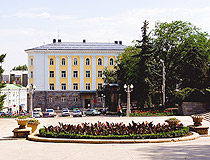
Stavropol architecture
Author: Jason Ramsey
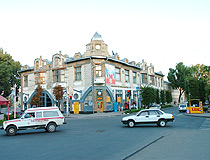
On the street in Stavropol
Author: Yuri Syuganov
Stavropol - Features
The name “Stavropol” reflects the practice of assigning pseudo-Greek names to new settlements, which was widespread in the Russian Empire at the end of the 18th century. Thus, Stavropol literally means “the city of the cross”. The reason for choosing this name is a matter of debate.
According to one version, it arose because the fortress in the plan had the shape of an elongated polygon, the basis of which was two intersecting axes resembling a cross. According to another version, during the laying of the foundation of the fortress, the builders dug out a large stone cross. According to the third version, when determining the places for the construction of the fortresses of the Azov-Mozdok defensive line, the Stavropol fortress was marked on the map not with a dot, like all other fortresses, but with a cross.
Stavropol stands on the hills in the central part of the Ciscaucasia on the Stavropol Upland, about 1,400 km south of Moscow, at the intersection of the Rostov - Stavropol and Astrakhan - Elista - Nevinnomyssk - Cherkessk highways. One of the streets of the city is named “The 45th parallel” indicating its exact latitudinal position. Thus, Stavropol is equidistant from the North Pole and from the equator.
It is located on the watershed of the Azov and Caspian Seas, in the middle between them. This location initially gave Stavropol an important geopolitical significance, which is quite accurately reflected in the aphorism “Stavropol - the gates of the Caucasus”.
The territory of Stavropol is stretched from the southwest to the northeast by 24 km and from the south to the north by 16 km. The peculiarity of the city is that the forests are adjacent to the city buildings. Stavropol is often called one of the greenest cities in Russia.
Stavropol is a city in the south of Russia, which determines its climatic features, especially the amount of solar heat. The tropical marine air from the Mediterranean Sea brings stifling, humid weather in summer, thaws in winter. The average temperature in January is minus 2.3 degrees Celsius, in July - plus 22.3 degrees Celsius. Stavropol is known for frequent strong winds with a speed of 20-25 m/s. The windiest months are February and March.
The federal highways R216 Stavropol - Elista - Astrakhan and R269 Stavropol - Bataysk pass through Stavropol. The airport of Stavropol offers regular flights to Moscow, St. Petersburg, Sochi. City transport is represented by buses, minibuses, trolleybuses, taxis. In summer, you can ride a bike around the city. The most popular rental point is located in Pobedy (Victory) Park.
The unique souvenirs for Stavropol include the healing herbal balsam “Strizhament” made from herbs and berries and infused with strong alcohol. Stavropol honey will be another tasty purchase. Gift soap made from Tambukan therapeutic mud and decorated with reliefs depicting Stavropol sights is also an excellent souvenir. Local hand-painted porcelain souvenirs with beautiful stucco decoration will also serve as a good memory of this city.
Main Attractions of Stavropol
Fortress Mountain - the historical center of Stavropol from where you can view most of the city from several observation decks. In the past, the Stavropol Fortress stood here. Here you can see one of the most recognizable symbols of Stavropol - the seven-meter monument to the Red Guard Soldier erected in the 1970s. Another attraction is a large light and music fountain with a diameter of 38 meters, opened in 2018. Sculptures installed along its edges depict 8 federal districts of Russia.
There is also the majestic Cathedral of the Kazan Icon of the Mother of God. Originally built in 1843-1847, it was destroyed in the 1930s. In 2004-2012, the church was restored and became the tallest building in the Stavropol region (76 meters). It is often windy on Fortress Mountain, so dress warmly. Suvorova Street, 2.
Alexandrovskaya Square - one of the central and busiest Stavropol squares, named in honor of Emperor Alexander II in the middle of the 19th century. The second name of this place is Angel Square due to the fact that a monument to the Guardian Angel of Stavropol was erected here by the 225th anniversary of the city. There are restaurants, offices, and shops in the surrounding area.
Stavropol State Museum-Reserve - the oldest museum in the North Caucasus. The museum collection is housed in the building of the former trading rows of the 19th century. More than 300 thousand items are stored and exhibited in the funds and expositions of this museum. The main exposition is represented by 3 halls: nature, archeology, and ethnography. Dzerzhinskogo Street, 135.
Stavropol Regional Museum of Fine Arts - one of the most interesting places in the city. The largest collection of art treasures in the North Caucasus is kept here. The museum has an impressive variety of monuments of ancient, Western European, Eastern, and Russian art. The department of decorative and applied arts has folk art and modern art objects. By visiting this unique place, you can learn a lot about the development of culture in the Stavropol region and the world from the 5th century BC to the 1990s. Dzerzhinskogo Street, 115-119.
Picture Gallery of P. M. Grechishkin - an art gallery located in the building of a former mosque in the central part of Stavropol. Its collection consists mainly of the works of the painter P. M. Grechishkin. In 1987, after the end of his personal exhibition, he donated more than 160 of his pictures to the city of Stavropol. The gallery also exhibits paintings by other artists - about 500 exhibits in total. Among them there are interesting works by young Stavropol artists. Mikhaila Morozova Street, 12.
Art Gallery “Parshin” - a private museum of contemporary art. Exhibitions of contemporary artists are held here, the staff conduct master classes and performances. The design of the gallery is a combination of Art Nouveau and interior elements imitating the old ones. General Ermolov Boulevard, 1.
St. Andrew’s Cathedral (1897) - a majestic church built in the Russian-Byzantine style with a pronounced central dome and a richly decorated facade. Dzerzhinskogo Street, 157.
Tiflis Gate - a triumphal arch erected in honor of the 30th anniversary of the Battle of Borodino (the key battle of the French invasion of Russia of 1812). The gate was located at the beginning of the Tiflis tract, from where carriages under the protection of the Cossacks departed in the direction of Vladikavkaz in the 19th century. In the 1930s, the monument was destroyed. In 1998, it was restored in its original appearance. Karla Marksa Avenue, 13.
Pobedy (Victory) Park - the main park of Stavropol with rides, cafes, and sports grounds typical for such a place. You can also find an equestrian club and a water park here. The park is quite crowded on weekends and on holidays. Shpakovskaya Street, 111.
Central Park of Stavropol. Its history began in the 19th century, when the mansion of General A. A. Velyaminov stood here, surrounded by a picturesque garden. Already at that time, the park had decorative flower beds, artificial ponds, benches, an orchestra platform, and a gazebo with a balcony. In Soviet times, it was repeatedly awarded the title of “The Best Park of the USSR”.
Cold Springs - a group of springs gushing out from under a layer of limestone, at an altitude of 620 meters above sea level in the Taman forest. You can get here from Dzerzhinsky Street or by walking a little down from the memorial “Cold Spring” on Lenina Street. There are a lot of pools built at different levels here, so that the water flows smoothly from one to another. The pools themselves have steps for easy descent.
In summer, people come to this dense cool forest with springs for picnics. The bravest ones plunge into cool water, the temperature of which always remains unchanged, about +10 degrees Celsius.
“German Bridges” - the remains of viaducts and bridges in the vicinity of Stavropol built at the beginning of the 20th century as parts of the Armavir-Tuapse railway, which was partially destroyed during the Russian Civil War. This name was given due to the fact that engineers from Europe, in particular from Germany, took part in the construction. Some of the bridges are still in service today.


